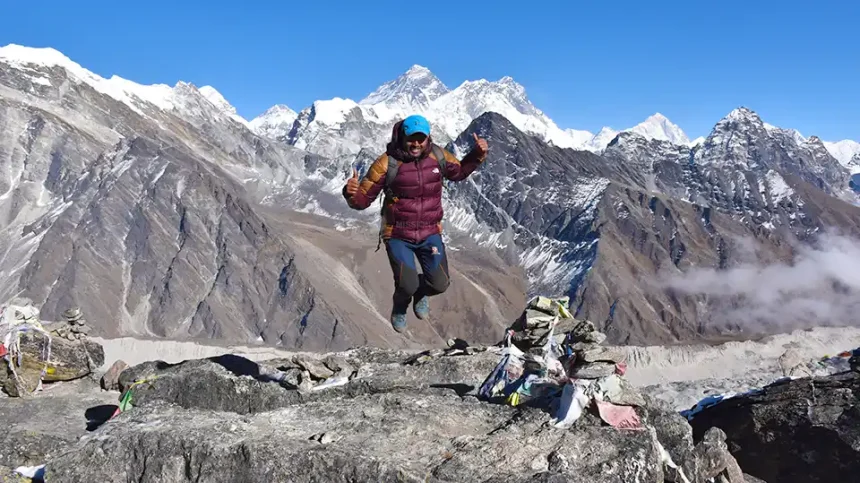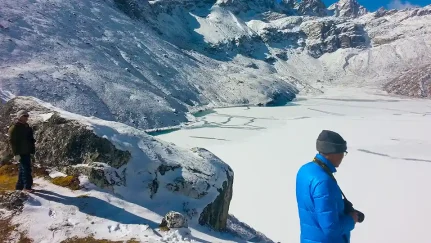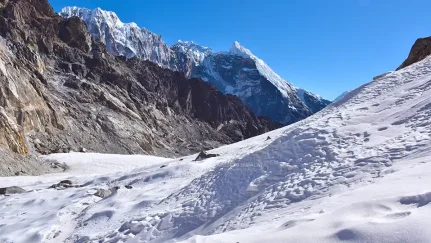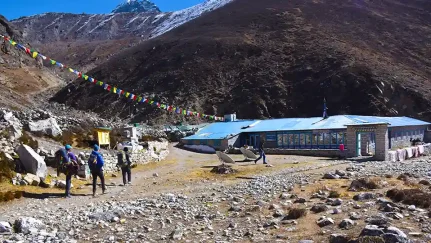Why the Three Passes Trek is Tougher than Everest Base Camp
If you are wondering how hard is Everest Three Passes Trek, it is important to know that this route is much tougher than the classic Everest Base Camp trek. While the Everest Base Camp trek is already a challenging journey, the Three Passes trek adds more distance, higher mountain passes, and longer walking days. Trekkers spend several hours on rocky, icy, and uneven trails each day. Some days may require 6–8 hours of walking, which tests both your body and mind. The Three Passes trek takes you over three high mountain passes, each above 5,300 meters, which makes the Everest Three Passes difficulty higher than the standard EBC trek.
The extra distance alone makes this trek strenuous. You will be walking several kilometers each day, often in cold, windy, and snowy conditions. Unlike the regular base camp route, there are fewer flat trails and more steep ascents and descents. The combination of altitude and terrain is a major reason why many trekkers consider how hard is Everest Three Passes Trek is compared to other treks in Nepal. The challenge is not just physical; mental endurance plays a key role. Trekking at high altitudes for several consecutive days can feel exhausting, and it requires focus and determination.
Altitude is another major factor that makes this trek difficult. Crossing passes above 5,300 meters puts you at a higher risk of Acute Mountain Sickness (AMS). Proper acclimatization is essential to avoid serious health issues. This is why the itinerary for the Three Passes trek usually includes rest and acclimatization days. Understanding Everest Three Passes trek difficulty explained helps trekkers prepare for the physical and mental demands of high-altitude trekking. Walking slowly, staying hydrated, and listening to your body are crucial parts of managing the altitude challenge.
- Everest Three Passes Trek Difficulty
Training is an important part of preparing for this strenuous trek. To answer the question how difficult is the Three Passes Trek in Everest, you need to build cardiovascular fitness, leg strength, and endurance before starting. Trekking with weight, climbing stairs, and doing cardio exercises like running or cycling are excellent ways to prepare. Many trekkers also include step training and hiking practice in hilly terrain to simulate the trekking conditions. A proper training plan for a challenging trek like this makes a significant difference in how comfortable and safe your journey will be.
Finally, it is important to recognize that this trek is designed for experienced and well-prepared trekkers. Unlike shorter treks, the Three Passes trek pushes you physically, mentally, and emotionally. If you are curious about how hard is Everest Three Passes Trek is, remember that it combines distance, high passes, long walking hours, and altitude challenges into one of the most demanding non-technical treks in Nepal. With proper preparation, training, and respect for the mountains, you can successfully complete this adventure and experience some of the most stunning landscapes in the Everest region.
What Fitness and Mindset You Need for the Trek
Many trekkers ask how hard is Everest Three Passes Trek and the answer often depends on both physical fitness and mental strength. This trek is considered one of Nepal’s most challenging non-technical treks because it combines long walking days, steep ascents, rocky trails, icy paths, and high passes above 5,300 meters. To face these challenges, you need a strong body and a resilient mind.
Physical fitness is the foundation of a successful trek. Trekking 6–8 hours a day requires strong legs, a good heart, and high endurance. Cardiovascular exercises such as running, swimming, cycling, or brisk walking help your heart and lungs adjust to long hours of activity. Leg strength is equally important. Exercises like squats, lunges, step-ups, and hiking on hilly terrain with a backpack simulate the effort needed on the trek. Many experienced trekkers follow a training plan for challenging trek like this for at least 6–8 weeks before their departure. This preparation improves stamina and reduces the risk of injuries along the trail.
- Everest Three Passes Trek Difficulty-Route
Carrying a weighted backpack is another effective way to train for the Everest Three Passes difficulty. Your body learns how to balance, strengthen your core, and adapt to the strain of walking uphill and downhill. Hiking with poles also strengthens the upper body and helps with stability on uneven terrain. Step training and interval workouts further enhance endurance, which is essential for this strenuous trek.
Mental strength is just as important as physical fitness on this journey. Walking long hours in cold, windy, and sometimes snowy conditions can be exhausting. You may face fatigue, sore muscles, or unexpected weather changes. Maintaining a calm, focused, and positive mindset is crucial. Trekking in a group or with a guide can help with motivation and decision-making when conditions are tough. Mental preparation also includes accepting slow progress, managing discomfort, and pacing yourself according to how your body feels at high altitude. Understanding Everest Three Passes trek difficulty explained helps trekkers set realistic expectations for both the physical and mental challenges ahead.
Altitude adaptation is another factor linked to fitness. A fit body recovers faster and adjusts more easily to lower oxygen levels, which reduces the risk of Acute Mountain Sickness (AMS). Following a proper acclimatization schedule, staying hydrated, and listening to your body are as important as physical workouts.
In conclusion, when people ask how difficult is the Three Passes Trek in Everest, the answer is that it demands a combination of strong physical fitness and resilient mental strength. With a focused training plan for challenging trek, regular cardio, leg strengthening, and practice hikes with weight, you prepare your body for long days on rocky, icy trails. Alongside this, a calm, patient, and positive mindset allows you to face the altitude challenge and complete the trek safely. This is why the question how hard is Everest Three Passes Trek is best answered by considering both preparation and perseverance. Trekkers who prepare well find the journey strenuous but deeply rewarding.
Altitude and Acclimatization: Staying Safe at 5,000 Meters
One of the main questions trekkers ask is how hard is Everest Three Passes Trek. A big part of the challenge comes from altitude. The trek crosses three high passes above 5,300 meters, which exposes trekkers to lower oxygen levels. This creates an altitude challenge that can lead to Acute Mountain Sickness (AMS) if you are not careful. Understanding Everest Three Passes trek difficulty explained is important because it helps you prepare for these high-altitude conditions and stay safe on the trail.
- Highest Pass of Everest Trail
Acclimatization is the key to preventing altitude sickness. The body needs time to adjust to lower oxygen, so rest days and slower walking are essential. Most itineraries for this strenuous trek include acclimatization days at key points. Walking slowly, even when you feel capable of moving faster, helps your body adapt. Avoiding sudden increases in altitude is very important, and it is better to spend extra time at a moderate height than to rush and risk illness.
Staying hydrated is another practical tip for managing high altitude. Drinking enough water supports circulation and helps your body adjust to thinner air. Avoiding alcohol and heavy meals at high altitude also reduces strain on your body. Trekkers should pay attention to signs of AMS, which include headache, nausea, dizziness, and shortness of breath. If symptoms worsen, descending to a lower altitude is the safest option. Being aware of Everest Three Passes difficulty ensures that you do not underestimate the risks.
Physical preparation before the trek also makes a big difference. Following a training plan for challenging trek that includes cardio, leg strengthening, and hiking with weight helps your body cope better at high altitude. A fit and strong body recovers faster and handles the stress of long walking days on rocky and icy trails. This preparation answers the common question how difficult is the Three Passes Trek in Everest, showing that a combination of training and acclimatization reduces risk and improves performance.
Using trekking poles can also help maintain balance on uneven terrain, reducing fatigue on steep ascents and descents. Sleeping well and taking rest whenever needed allows the body to recover and adjust. Planning your pace and respecting your limits is as important as physical fitness. Many experienced trekkers agree that how hard is Everest Three Passes Trek depends not only on distance and terrain but also on how well you manage altitude.
In conclusion, altitude and acclimatization are critical factors when considering how hard is Everest Three Passes Trek. The risk of AMS, long walking days, and high mountain passes makes this one of the most challenging non-technical treks in Nepal. By walking slowly, staying hydrated, resting properly, and training before the trek, you can manage the Everest Three Passes trek difficulty safely. Preparing your body and mind for the altitude challenge allows you to enjoy the journey and complete the trek successfully. For trekkers who plan well, the rewards of reaching the high passes make the effort worthwhile.
- Guest Enjoy Meal in Three Passes Trek
Conclusion of Everest Three Passes Trek Difficulty
The Everest Three Passes Trek is not just a journey; it is a true test of endurance, strength, and determination. Many people ask how hard is Everest Three Passes Trek, and the answer depends on understanding its physical, mental, and altitude challenges. This trek is considered one of Nepal’s most demanding non-technical treks because it combines long walking days, high mountain passes above 5,300 meters, rocky trails, and icy paths. The extra distance and steep ascents make it far more difficult than the standard Everest Base Camp trek, giving trekkers a real sense of accomplishment when they complete it.
Physical preparation is essential. Trekking 6–8 hours a day on uneven terrain requires strong legs, good stamina, and excellent cardiovascular fitness. Following a training plan for challenging trek, including step training, hiking with weight, and cardio exercises, helps your body handle the strain. Mental resilience is equally important. Trekking at high altitudes can be exhausting and sometimes uncomfortable, so staying focused, patient, and positive is key. Understanding the Everest Three Passes difficulty before starting allows trekkers to pace themselves and manage expectations.
- EBC With Three pass Trek
Altitude and acclimatization are also critical factors. The risk of Acute Mountain Sickness (AMS) means that rest days, slow walking, and proper hydration are not optional. Preparing your body with physical training and giving it time to adjust at higher elevations helps reduce risks and makes the trek safer. For anyone wondering how difficult is the Three Passes Trek in Everest, it is clear that careful preparation, fitness, and a strong mindset are the most important tools for success.
Ultimately, how hard is Everest Three Passes Trek comes down to preparation and perseverance. For those willing to commit to training, respect the altitude, and embrace the challenge, this trek offers some of the most stunning landscapes, rewarding experiences, and unforgettable memories in the Everest region. It is a journey that tests limits but also inspires a deep sense of achievement.
















